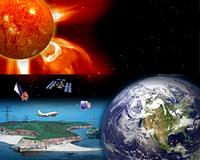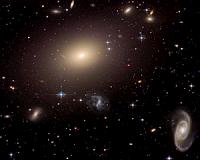|
 Exoplanet Caught On The Move
Exoplanet Caught On The MoveParis, France (SPX) Jun 11, 2010 For the first time, astronomers have been able to directly follow the motion of an exoplanet as it moves from one side of its host star to the other. The planet has the smallest orbit so far of all directly imaged exoplanets, lying almost as close to its parent star as Saturn is to the Sun. Scientists believe that it may have formed in a similar way to the giant planets in the Solar System. Because the star is so young, this discovery proves that gas giant planets can form within discs in only a f ... read more |
. |
|
|
Free Space, Earth, Energy And Military Newsletters - Delivered Daily |
| . | . |
| .. |
The Earth And Moon Formed Later Than Previously Thought Copenhagen, Denmark (SPX) Jun 08, 2010
Copenhagen, Denmark (SPX) Jun 08, 2010The Earth and Moon were created as the result of a giant collision between two planets the size of Mars and Venus. Until now it was thought to have happened when the solar system was 30 million years old or approx. 4,537 million years ago. But new research from the Niels Bohr Institute shows that the Earth and Moon must have formed much later - perhaps up to 150 million years after the for ... more Purdue To Lead NASA Study On Cells In Microgravity  West Lafayette IN (SPX) Jun 08, 2010
West Lafayette IN (SPX) Jun 08, 2010NASA has awarded a $2 million project to Purdue University for a microsatellite experiment to determine how plant cells react to different gravity situations. Marshall Porterfield, a professor of agricultural and biological engineering and horticulture and landscape architecture, is developing lab-on-a-chip technology that allows for the study and measurement of microscopic cellular sample ... more Journey To The Stars  Huntsville AL (SPX) Jun 08, 2010
Huntsville AL (SPX) Jun 08, 2010Kids love to make things explode in science class. How about an entire star? Thanks to NASA, supernovas will soon be going off in classrooms around the country-no safety glasses required. It's done via a DVD called Journey to the Stars. Teachers can request a free copy along with supporting lesson plans and activity sheets at journeytothestars.org. "We want every classroom in the country t ... more |
.. |
 NASA Keeping A Wary Eye On Space Weather  Computers Automatically Classify Galaxy Shapes  Instant online solar energy quotes Solar Energy Solutions from ABC Solar |
.. |
|
|
Free Space, Earth, Energy And Military Newsletters - Delivered Daily |
|
|
. |
 Next Stop, Titan: Looking At The Land o' Lakes
Next Stop, Titan: Looking At The Land o' LakesPasadena CA (JPL) Jun 07, 2010 NASA's Cassini spacecraft will be eyeing the north polar region of Saturn's moon Titan this weekend, scanning the moon's land o' lakes. At closest approach on early morning Saturday, June 5 UTC, which is Friday afternoon, June 4 Pacific time, Cassini will glide to within about 2,000 kilometers (1,300 miles) of the Titan surface. Cassini will make infrared scans of the north polar region, which was in darkness for the first several years of Cassini's tour around the Saturn system. The lightin ... read more |
| The contents herein, unless otherwise known to be public domain, are Copyright 1995-2010 - SpaceDaily. AFP and UPI Wire Stories are copyright Agence France-Presse and United Press International. ESA Portal Reports are copyright European Space Agency. All NASA sourced material is public domain. Additional copyrights may apply in whole or part to other bona fide parties. Advertising does not imply endorsement, agreement or approval of any opinions, statements or information provided by SpaceDaily on any web page published or hosted by SpaceDaily. Privacy statement |
| Previous Issues | Jun 10 | Jun 09 | Jun 08 | Jun 07 | Jun 04 |